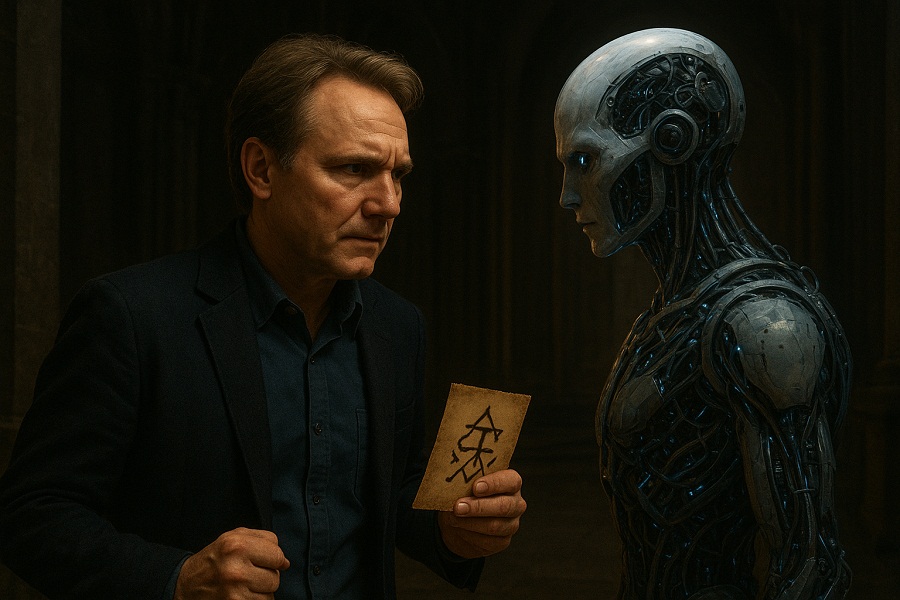Why does Dan Brown still stay ahead in a world ruled by AI?

Published :
Updated :

A man wanders through a shadowed church in Rome, clutching a note marked with strange symbols. He recalls racing through Paris to decode a secret hidden in a da Vinci painting, then standing beneath the Florentine Duomo as death itself seemed woven into the architecture.
In Washington, he once uncovered mysteries that blended ancient masonry with national destiny. And in Barcelona, he confronted a question few dare to ask: Can machines rival the divine spark of human thought? This wandering figure is Robert Langdon, yet behind him stands the unmistakable hand of Dan Brown—an author who has spent decades weaving puzzles that tangle art, science, and faith into a single thread. His stories are not just adventures; they are reminders that even in an era ruled by algorithms, the human imagination refuses to be outpaced.
Now, in his imagined return to Prague, Brown places Langdon at the heart of another collision between cutting-edge science and old-world myth. Katherine Solomon, a brilliant noetic scientist, prepares to unveil research that questions the very nature of consciousness, suggesting that the human mind holds mysteries deeper than any machine learning model could simulate.
Before her revelations reach the world, violence intervenes. A murder twists the story, a manuscript vanishes, and Langdon finds himself pursued by figures who seem to have been lifted straight from Czech folklore. The chase carries him across cities, London, New York—where the line between scientific progress and mystical history grows thinner at every turn.
What makes this more than another thriller is how it echoes the ongoing tension between artificial intelligence and human creativity. At a time when AI is hailed as the ultimate predictor, problem-solver, and even storyteller, Brown insists on a different truth, the mind is not simply a processor of data.
This is not new for Brown. Angels & Demons pitted science and faith against one another inside the Vatican walls, reminding readers that CERN's particle collider could be as dangerous—and as awe-inspiring—as any relic.
The Da Vinci Code thrust ancient codes into a modern setting, making readers reconsider the fine line between legend and doctrine.
The Lost Symbol placed the U.S. capital under a lens, merging Freemasonry with questions of human potential. And in Origin, Brown came closest to brushing against AI itself—introducing Edmond Kirsch's futuristic machine that claimed to answer humanity's oldest questions, where we came from and where we are going. Each book, in its own way, has been less about the chase and more about exposing how fragile certainty really is.
Machines may write competent essays, design complex algorithms, or predict consumer behaviour with eerie precision. Yet they struggle with ambiguity, the kind of layered meaning hidden in religious iconography or cultural folklore—the very soil Brown cultivates.
Katherine Solomon's research on consciousness suggests that the mind may not be reducible to neurons firing in sequence. If true, this would be a direct challenge to the mechanistic vision AI represents.
For readers today, the implication is sharp: What if the most essential part of us—the imagination, the capacity for awe, the drive to believe—cannot be replicated by code?
Brown has always understood the power of myth as more than a decorative background. He uses ancient texts and artworks not merely as props but as keys to questions technology cannot answer.
When Langdon examines Botticelli's map in Inferno or deciphers Gaudí's architecture in Origin, he is not solving puzzles for their own sake. He is showing how human culture encodes meaning that outlasts empires and inventions. And here lies Brown's enduring edge over artificial intelligence: meaning is not easily programmable. It requires leaps of association, emotional resonance, and yes, even superstition.
What critics often miss is how Brown anticipates cultural debates years before they hit the mainstream. Long before conspiracy theories dominated online spaces, The Da Vinci Code exposed the fragility of accepted narratives.
Before the political polarisation of science and religion grew as sharp as it is today, Angels & Demons dramatised the clash.
Before AI headlines crowded the news, Origin asked whether machines might one day become humanity's new guardians. His plots may sometimes lean on formula, but his choice of themes consistently runs ahead of the cultural curve.
In a world drowning in data, Brown's work insists on mystery. AI thrives on prediction, on reducing uncertainty to manageable patterns. But Brown's novels succeed because they embrace uncertainty, asking readers to sit in the discomfort of not knowing.
Whether it's the hidden message in a Renaissance painting or the possibility of a soul beyond neurons, he refuses to let the story collapse into a simple explanation. That refusal is precisely what keeps him relevant.
For readers tired of machine-generated summaries and automated feeds, Brown offers something radically human: the thrill of being lost in a labyrinth of clues with no guarantee of resolution.
His characters, especially Langdon, are not superheroes but scholars—figures whose strength lies not in physical force but in their ability to interpret and understand. In that sense, they mirror what humans still do best: interpreting, imagining, and believing.
So why, in the age of AI, is Dan Brown more than relevant? Because he crafts narratives that remind us that data is not destiny. He writes stories where knowledge is power, but only when paired with intuition and courage. And most importantly, he insists that mystery itself has value—that the unknown is not a flaw in the system, but the very reason we keep searching.
raiyanjuir@gmail.com


 For all latest news, follow The Financial Express Google News channel.
For all latest news, follow The Financial Express Google News channel.